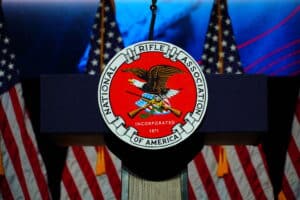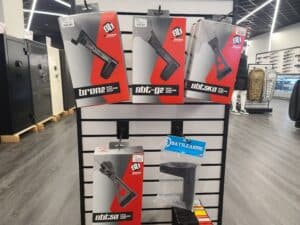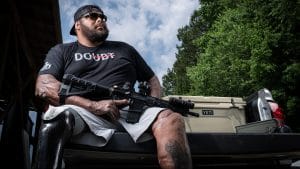Only a fraction of the guns affected by the ATF’s new rule were registered with the agency during the four-month grace period that ended this week.
The ATF told The Reload on Friday it has received just over a quarter million applications to register pistol-brace-equipped firearms. Registering the affected guns was one path toward avoiding possible criminal punishment for possessing the guns under the National Firearms Act of 1934 (NFA) after the agency implemented a rule reclassifying the firearms as subject to NFA restrictions. The ATF waived the tax requirement for registration to encourage owners to comply before the deadline.
“The final rule provided possessors of such firearms the option to comply with the registration requirements of the National Firearms Act through a tax-free process using either the ATF eForms System or a paper application process with a deadline for such applications of 11:59 PM (ET) on May 31, 2023,” Erik Longnecker, Deputy Chief of the ATF’s Public Affairs Division, told The Reload. “As of June 1, 2023, ATF received 255,162 applications for tax-free registration.”
That number represents just a fraction of the braced guns believed to have been sold in the decade since the ATF first classified a version as outside the scope of the NFA. In the impact assessment for the rule, the ATF estimated that three to seven million devices exist. However, the Congressional Research Service puts the number much higher at somewhere between 10 and 40 million.
That puts the registration rate for pistol-brace-equipped guns at between 0.6 percent and eight percent.
Longnecker noted that owners of the affected guns could also comply with the rule by either dismantling the firearms and destroying the braces or turning them over to the ATF. He said the agency does not know how many Americans may have taken those routes.
“ATF is unable to estimate the number of possessors of such firearms that used either of these methods to comply with the final rule,” he said. “Likewise, we have no data currently available for the number of firearms abandoned to ATF.”
The rule has been a source of significant controversy since the ATF submitted it at the behest of President Joe Biden. Gun-rights advocates have labeled it unconstitutional, with every major gun group filing suit against it after it went into effect in January, and some owners have said they would refuse to comply with it. The registration numbers indicate many carried through on that promise.
However, Attorney General Merrick Garland (D.) has continually defended the rule change. He has said the reclassification of braced guns will prevent crimes committed with them by subjecting them to far stricter regulations under the NFA.
“Keeping our communities safe from gun violence is among the Department’s highest priorities,” he said in a statement after the rule was announced. “Almost a century ago, Congress determined that short-barreled rifles must be subject to heightened requirements. Today’s rule makes clear that firearm manufacturers, dealers, and individuals cannot evade these important public safety protections simply by adding accessories to pistols that transform them into short-barreled rifles.”
The NFA regulates certain kinds of short-barreled semi-automatic firearms in the same way it does machineguns and silencers. The law requires Americans to register any “rifles” with a barrel shorter than 16 inches or a “shotgun” with a barrel shorter than 18 inches. The registration is meant to prove the owner paid the $200 tax at the law’s core. The registration process is slow, often taking up to a year to complete. But anyone caught with an unregistered NFA item could be subject to a federal felony charge, which carries up to ten years in prison.
The complicating factor is that the NFA defines “rifles” and “shotguns” as guns that are “designed and intended” to be shouldered. In 2012, the ATF determined the first firearms equipped with pistol braces, which are designed to be strapped to a shooter’s forearm instead of pressed against their shoulder, were not rifles. That meant they were not subject to NFA regulations even if they had barrels shorter than 16 inches long.
Over the next decade, the agency issued a slew of determinations on different versions of pistol braces that further muddied the waters on what was and wasn’t subject to the NFA. A few years after the first determination, during the Obama Administration, the agency issued another claiming that pressing a pistol brace to a shooter’s shoulder constituted a redesign of the device and turned it into an unregistered short-barrel rifle. It later rescinded that declaration under the Trump Administration. The inconsistency led to increasing complaints from owners and the gun industry that the agency was inconsistent and subjective in its determinations.
The new rule, issued under the Biden Administration, purports to be based on more objective criteria but still relies on many subjective measures, including whether the agency believes “indirect marketing” of a brace shows it is meant to be shouldered. In practice, it classifies nearly all pistol-brace-equipped firearms as unregistered short-barrel rifles. With the deadline to register previously-owned braced guns now passed, anyone caught with one could now face charges.
However, millions of gun owners don’t have to worry about that for the time being because of recent injunctions issued by a collection of federal judges. A Fifth Circuit Court of Appeals panel issued an injunction just days before the end of the grace period that blocks the ATF from enforcing its rule against Firearms Policy Coalition members or Maxim Defense customers. A second judge in the same circuit followed up by issuing one for Second Amendment Foundation members. A third did the same for Gun Owners of America members.
“Nothing in this order is to be construed as a comment on the merits of any issue that this panel may ultimately address,” the Fifth Circuit panel wrote in the order. “The limited purpose of this clarification is to preserve the status quo ante to provide what the agency defendants term ‘complete relief’ to the parties and persons within the reasonable scope of the motion panel’s injunction pending appeal.”
That protects many who may have decided not to register or turn in their guns, but it leaves potentially millions more at risk of prosecution. Other suits against the rule outside the Fifth Circuit, such as the one filed in the Eighth Circuit by the National Rifle Association, have yet to see a ruling.
Longnecker said the ATF could not say how the injunctions would affect its enforcement strategy in the short term.
“We are unable to comment on any future actions due to ongoing litigation.”
The Fifth Circuit panel put the case on an expedited schedule when it released its injunction. Hearings in the case are set to begin on June 29th.







2 Responses
Weird question about this. I didn’t try this because I don’t have any pistol braces, or uppers <16", but it seems like this would have been a cheap/fast/quick way to get a genuine SBR.
Take your pistol braced pistol, register it as an SBR under the registration period, dump the pistol brace and put a regular stock on it (hey it's just another SBR now), and voila! real SBR.
Yea, that’s a good question. I’m not positive how the ATF is handling that scenario. I’m not sure if they have any way of discerning the braced guns from the SBRs with stocks.